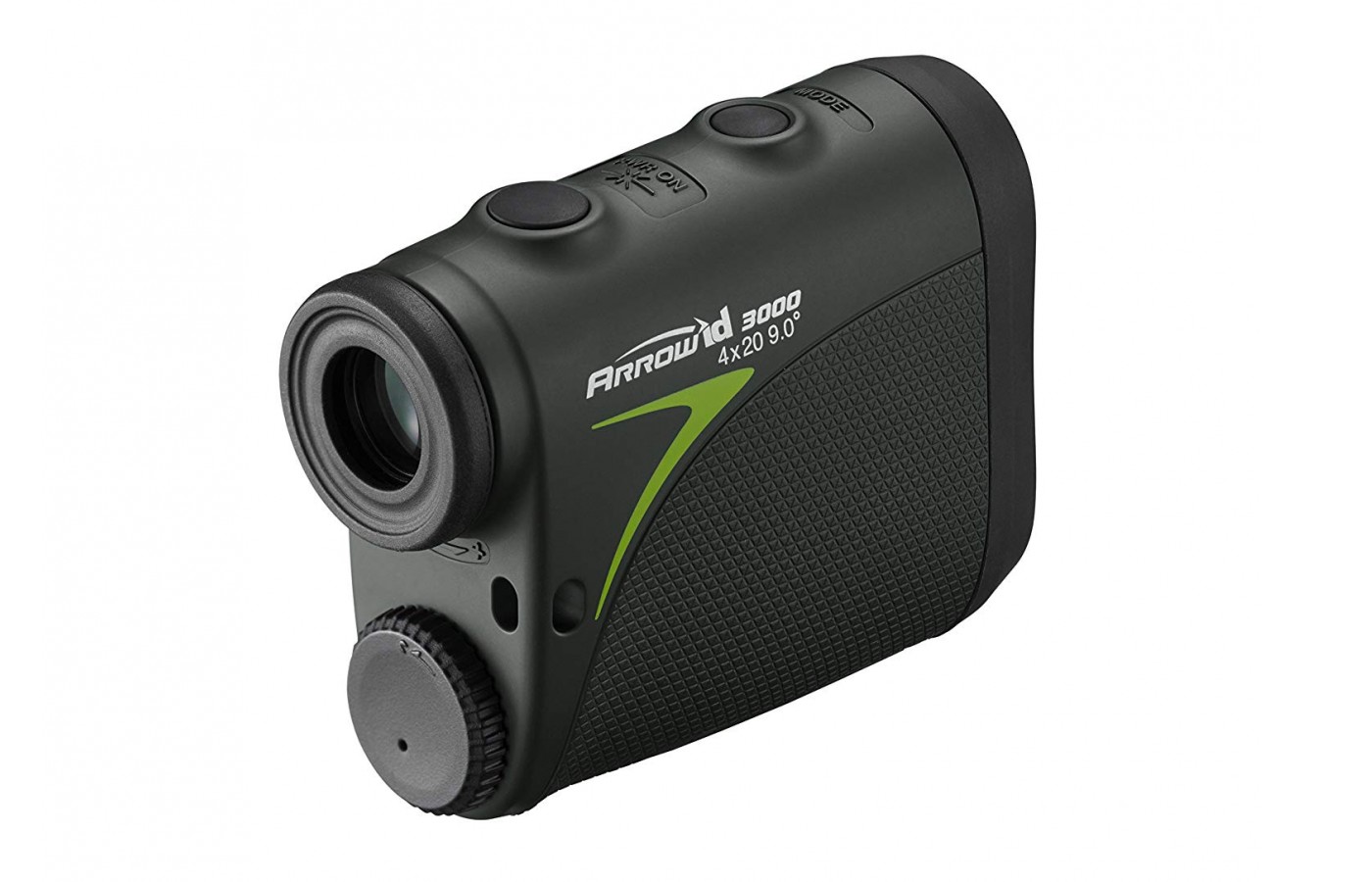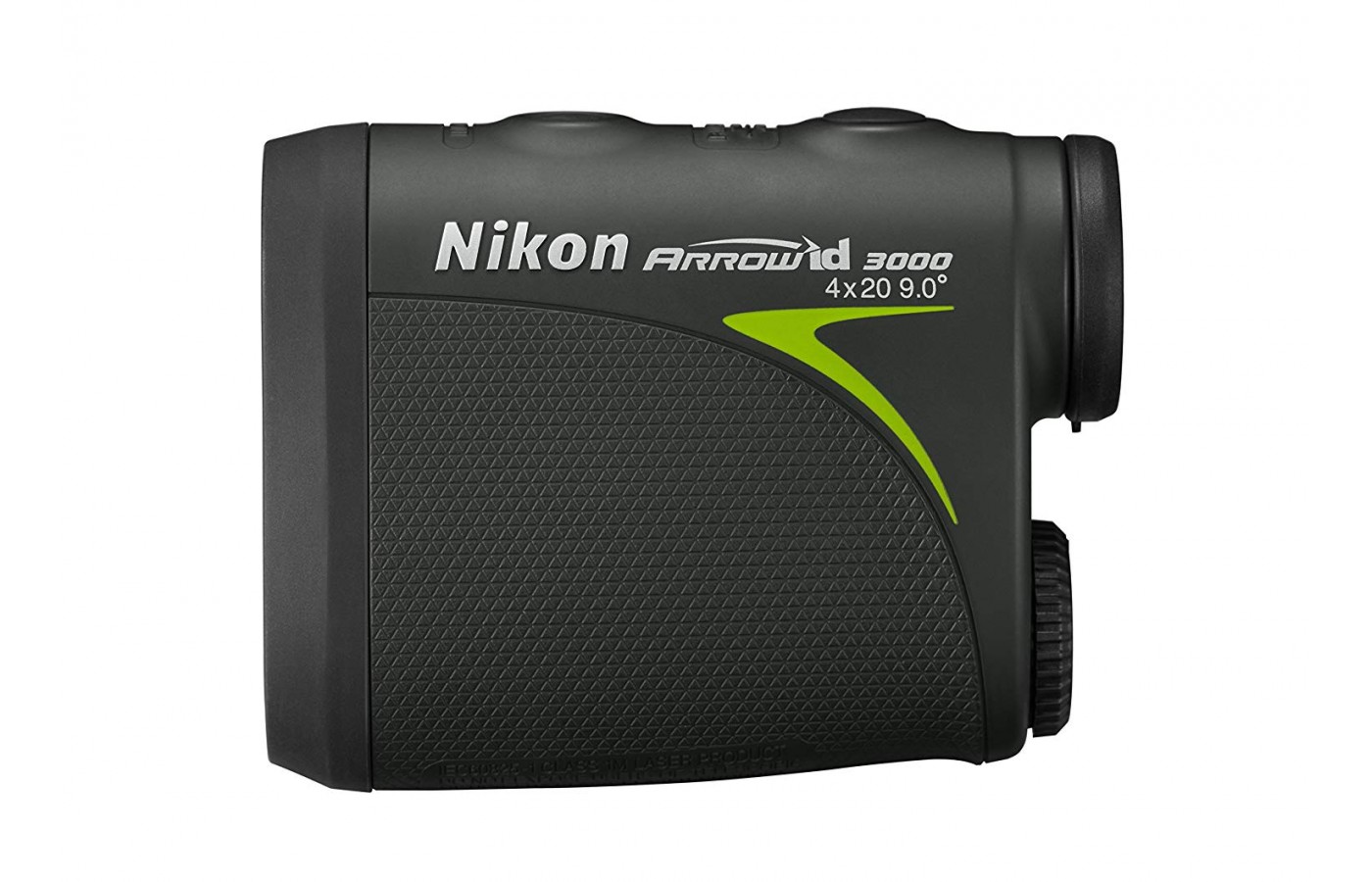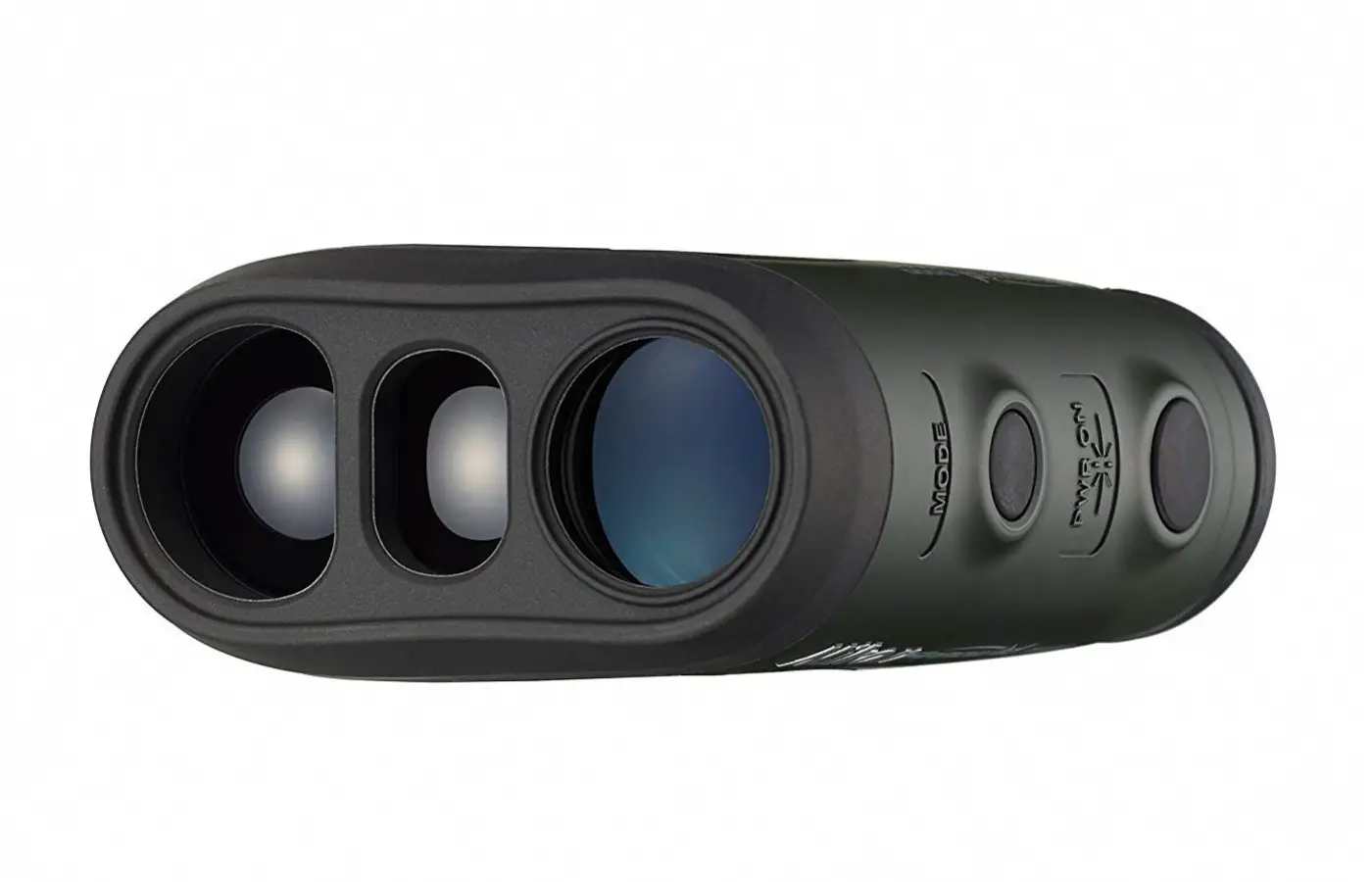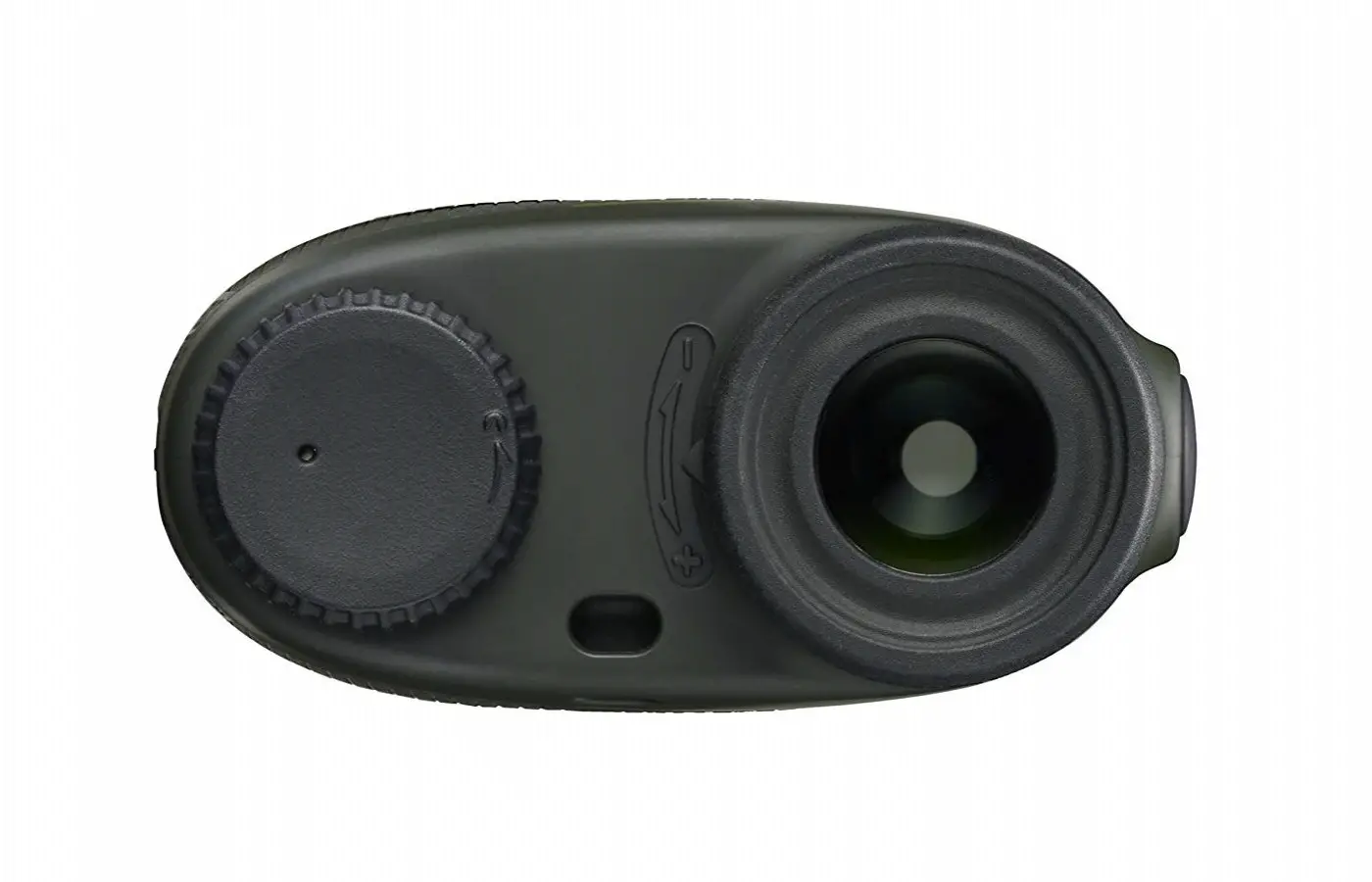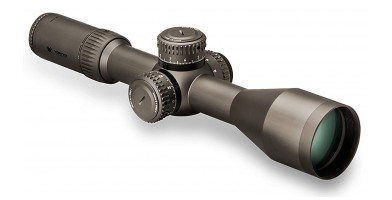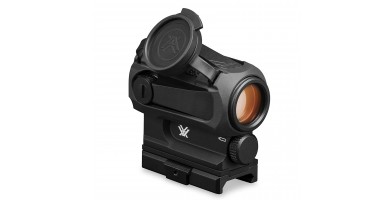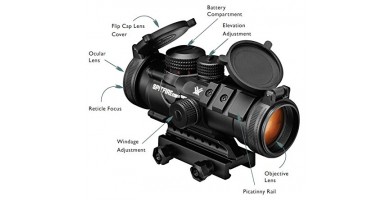Nikon Arrow ID 3000
Nikon Arrow ID 3000 Review Facts
The Nikon Arrow ID 3000 caters to bowhunters. It is compact, lightweight, and affordable. The bowhunting features are just what hunters need. The Nikon rangefinder receives two thumbs up from the masses.
Defective units are rarely in circulation. Nikon offers warranties they stand behind. The features people rave about are its ready on demand benefit, great glass, and compact size. The device is a match for those who want only angle readings and horizontal distances or true distance readings.
Editor's Pros & Cons
Pros
- Designed for bowhunters
- Extended eye relief for users who wear glasses
- Price
- Slope measurements
- Tru Target Technology
Cons
- Data on display screen could be brighter
- No true carrying case
- Not submersible
Basic Features
The device is packed with features that make life easier. The Nikon Arrow ID 3000 is an incredibly small unit. It is 3.3 inches tall, 1.5 inches wide, and 2.9 inches long. Without the battery, the unit weighs 4.8 ounces. It can be carried all day without strain.
There is no strain on the eyes either. The 20.3mm eye relief extension means those who wear glasses can use the gadget. The unit comes with a neoprene case; It keeps the unit in a water-resistant mode.
The case is more of a lens cover that provides some protection and water-resistance. The rear has no cap. At first, the cover is stiff and does not open enough to keep from impairing the view.
One tested folder it back and set the rangefinder on the cover overnight. So that it falls below the view. When broken in, the case is a bit flimsy but makes little noise which is critical when hunting.
There is also a strap that hunters have come to appreciate. It can be hung around the neck or elsewhere. It offers an opportunity to keep the rangefinder on the chest or at the side the entire time one is hunting. The strap makes the device easily accessible.
There is no strain on the eyes either. The 20.3mm eye relief extension means those who wear glasses can use the gadget. The unit comes with a neoprene case; It keeps the unit in a water-resistant mode.
The case is more of a lens cover that provides some protection and water-resistance. The rear has no cap. At first, the cover is stiff and does not open enough to keep from impairing the view.
One tested folder it back and set the rangefinder on the cover overnight. So that it falls below the view. When broken in, the case is a bit flimsy but makes little noise which is critical when hunting.
There is also a strap that hunters have come to appreciate. It can be hung around the neck or elsewhere. It offers an opportunity to keep the rangefinder on the chest or at the side the entire time one is hunting. The strap makes the device easily accessible.
Advanced Features
It has Tru Target Technology and angle compensation features. The ID technology ensures horizontal distance compensation to the target. It compensates for bolt and arrow drop. The improved ID technology is another favorite feature of bowhunters.
It is concerned with incline and decline. ID Technology is useful when the hunter is in a deer stand, and the deer is on the ground, or the hunter is in a valley, and the deer is above him or her. The ID in the name stands for Incline and Decline.
That technology provides the horizontal distance from a target for both rifle hunters and archers so that they can make adjustments to the weapon. It allows a user to determine an accurate target distance no matter what the horizontal range or the incline or decline. The unit compensates for the terrain slope. The rangefinder takes out all the guesswork for taking a shot.
A more accurate distance determination is made.
The angle of calculation is ∓89 degrees. It tells exactly where to aim and, allows the hunter to worry about the shot. The unit ranges up to 550 yards in ideal condition with a reflective target. A dark tree in the background at 550 yards is not going to register.
Today’s technology allows a lot of advances. Nikon has gone above and beyond. No longer do hunters have to walk distances and hang ribbons to know how far out a target is. Use
Often bowhunters don’t shoot over 50 to 70 yards. Pushing the 'on' button once sends out the quick range. Push and hold for eight seconds, and it catches ranges and sends back information consistently from wherever the target is.
Rifle shooters can also use the rangefinder. The Tru Target Technology is convenient for both kinds of hunters. It allows the rangefinder to switch back and forth between target modes. The first target mode ignores background objects to acquire the distance to the nearest object. The second target mode ignores foreground objects and brush to get background target acquisition.
It is concerned with incline and decline. ID Technology is useful when the hunter is in a deer stand, and the deer is on the ground, or the hunter is in a valley, and the deer is above him or her. The ID in the name stands for Incline and Decline.
That technology provides the horizontal distance from a target for both rifle hunters and archers so that they can make adjustments to the weapon. It allows a user to determine an accurate target distance no matter what the horizontal range or the incline or decline. The unit compensates for the terrain slope. The rangefinder takes out all the guesswork for taking a shot.
A more accurate distance determination is made.
The angle of calculation is ∓89 degrees. It tells exactly where to aim and, allows the hunter to worry about the shot. The unit ranges up to 550 yards in ideal condition with a reflective target. A dark tree in the background at 550 yards is not going to register.
Today’s technology allows a lot of advances. Nikon has gone above and beyond. No longer do hunters have to walk distances and hang ribbons to know how far out a target is. Use
Often bowhunters don’t shoot over 50 to 70 yards. Pushing the 'on' button once sends out the quick range. Push and hold for eight seconds, and it catches ranges and sends back information consistently from wherever the target is.
Rifle shooters can also use the rangefinder. The Tru Target Technology is convenient for both kinds of hunters. It allows the rangefinder to switch back and forth between target modes. The first target mode ignores background objects to acquire the distance to the nearest object. The second target mode ignores foreground objects and brush to get background target acquisition.
Power Source
A new CR2 battery provides 8000 actuations. The battery included with the purchase is used to check operation before releasing for sale. It most likely will not last as long.
Accuracy
The user can switch from first to second target modes, dependent on the environment and terrain, to get accurate distances needed to take down a target. The rangefinder makes shots accurate and dead on whether the target is below, above, or horizontal to the shooter.
The range of accuracy is under perfect conditions and large reflective targets. Under those conditions, the device is capable of measuring distances ranging from six to 500 or more yards. Most manufacturers provide yardage details.
Nikon chose not to do so, but testers have discovered that the Arrow ID 3000 is more accurate under normal, not perfect, conditions for about 200 yards for game. The longest distance for a mountain range was nearly 456 yards.
The range of accuracy is under perfect conditions and large reflective targets. Under those conditions, the device is capable of measuring distances ranging from six to 500 or more yards. Most manufacturers provide yardage details.
Nikon chose not to do so, but testers have discovered that the Arrow ID 3000 is more accurate under normal, not perfect, conditions for about 200 yards for game. The longest distance for a mountain range was nearly 456 yards.
Durability
The Arrow ID 300 cannot be submerged in water. It is water and rainproof, having an IPX (Internetwork Packet Exchange) rating. Hunting when it rains is possible, even if it pours. However, submerging in water will cause significant problems.
The housing of the Arrow ID is not sealed. Water will corrupt internal mechanism. The guarantee does not include damage under all conditions. Keep the unit as dry as possible. The quality is exceptional. One tester feels the rangefinder will make him a better bowhunter.
The Arrow ID 300 is an improvement over the discontinued 500. The difference lies in the eye relief and size. The 3000 is a compact version. It has longer eye relief. The 500 was waterproof; the 3000 model is not. Both offer the same benefits. The device is small and lightweight. It fits in the palm. It has an ergonomic and design; rainproof, water-resistant housing; and excellent eye relief.
The housing of the Arrow ID is not sealed. Water will corrupt internal mechanism. The guarantee does not include damage under all conditions. Keep the unit as dry as possible. The quality is exceptional. One tester feels the rangefinder will make him a better bowhunter.
The Arrow ID 300 is an improvement over the discontinued 500. The difference lies in the eye relief and size. The 3000 is a compact version. It has longer eye relief. The 500 was waterproof; the 3000 model is not. Both offer the same benefits. The device is small and lightweight. It fits in the palm. It has an ergonomic and design; rainproof, water-resistant housing; and excellent eye relief.
Ease of Use
The instruction manual makes the device seem more complicated than it is. The positive review comments outnumber the few negative comments from testers. It is user-friendly, having a simple, single button control and a large 18mm ocular.
Tru Target Technology is phenomenal. It affords the opportunity to put the rangefinder in the distant mode when the game is behind tall grass or brush and about to head out. The rangefinder takes the guesswork out of knowing where the target is.
In DST mode, the rangefinder shoots the farthest within the area. It declutters the foreground and helps find the game in the background. Five or ten yards can make a difference when a hunter is shooting.
The Power button is closest to the shooter. It is also the one used to range the target. Press and hold to use the scan feature. Most rangefinders have either First or Distant Target Priority Mode. They differ in what is seen first.
Hunters don’t use golf rangefinders. Golfers don’t use hunting rangefinders. Each is developed for a specific purpose that overcomes obstacles for a particular user. The Arrow ID 3000 offers the best of both worlds.
Many people misunderstand the way a rangefinder functions and calculations distances for a variety of targets. This device would not be useful for a rifle or shotgun hunter who wants to shoot a deer at a distance of 500 yards.
The 200-yard accuracy is excellent for bowhunters. For them, there would be no reason to have a rangefinder that measures 1000 yards. The Nikon Arrow ID 3000 works relatively well in low-light conditions. Blackface targets could be detected.
The First Priority Mode is used for wide open spaces. The Distant Target Priority looks past obstacles to a target standing in the distance. The two-mode choice allows the rangefinder to be used in many terrains with little hassle.
As the name implies, the device was designed for bowhunters. Tailored for archery competition and bowhunters, the Arrow ID 3000 calculates immediate ‘shoot for’ distance. ID Technology gives the target’s horizontal distance not holdover options or bullet drop.
Tru Target Technology is phenomenal. It affords the opportunity to put the rangefinder in the distant mode when the game is behind tall grass or brush and about to head out. The rangefinder takes the guesswork out of knowing where the target is.
In DST mode, the rangefinder shoots the farthest within the area. It declutters the foreground and helps find the game in the background. Five or ten yards can make a difference when a hunter is shooting.
The Power button is closest to the shooter. It is also the one used to range the target. Press and hold to use the scan feature. Most rangefinders have either First or Distant Target Priority Mode. They differ in what is seen first.
Hunters don’t use golf rangefinders. Golfers don’t use hunting rangefinders. Each is developed for a specific purpose that overcomes obstacles for a particular user. The Arrow ID 3000 offers the best of both worlds.
Many people misunderstand the way a rangefinder functions and calculations distances for a variety of targets. This device would not be useful for a rifle or shotgun hunter who wants to shoot a deer at a distance of 500 yards.
The 200-yard accuracy is excellent for bowhunters. For them, there would be no reason to have a rangefinder that measures 1000 yards. The Nikon Arrow ID 3000 works relatively well in low-light conditions. Blackface targets could be detected.
The First Priority Mode is used for wide open spaces. The Distant Target Priority looks past obstacles to a target standing in the distance. The two-mode choice allows the rangefinder to be used in many terrains with little hassle.
As the name implies, the device was designed for bowhunters. Tailored for archery competition and bowhunters, the Arrow ID 3000 calculates immediate ‘shoot for’ distance. ID Technology gives the target’s horizontal distance not holdover options or bullet drop.
Display
Out of the box, the Arrow ID 3000 is the number one rangefinder for clarity. Bowhunters need a quality rangefinder. The unit has an uncluttered design. Bowhunters do not want a plethora of lines, numbers, and letters on the screen that they have no idea what they mean.
The display on the Arrow ID 3000 is simple. When the button is hit, the yardage from the target is all that is displayed or needed. If the rangefinder is not quick and reliable, it is a waste of money.
It has a zoom, which is essential for bowhunting, that allows for a wide field of view. A magnification of 4X may not be the option best for rifle hunters, but for archery and bowhunters, it works beautifully.
It is likely the best rangefinder a bowhunter can find. ID Technology is the default setting for the rangefinder. Nikon chose not to put a lot of information on the display. It displays yardage and some abbreviations that indicate the mode being used.
‘Ang’ is seen on the LCD near the bottom and left of the reticle when the ID technology is enabled. To switch between that technology and the line of the sight the Mode button is depressed, immediately followed by depressing the Power for no more than two seconds.
‘1st’ below the reticle indicates the First Target Priority Mode is activated. ‘Dst’ is seen on the lower right of the reticle when the Distant Target Priority Mode is on. To switch between the target modes the Mode button is held down and the Power button is immediately depressed.
Pressing both for more than two seconds switches modes. Angle and true distance readings do not appear on the same mode. After eight seconds of inactivity, the rangefinder automatically shuts off. Many hunters see the ability to scan an area for distance updates as a must-have feature.
When activated, the rangefinder scans for eight continuous seconds. The eight seconds of constant measurement allows the shooter to scroll the landscape and pick out a variety of landmark distances.
The optics have a multi-layered coating. The eye relief of the Arrow ID 3000 is an impressive 20.3mm. This is a critical detail for those who wear glasses. The distance needed for eye relief differs for rangefinders. It is based on the design of the unit.
There is not integrated elevation compensation. Vertical and horizontal distances are shown in different modes. The objective lens measures 20mm. The Red Out of the LCD is black, which makes using it in low-light situations difficult.
The ocular has a diopter adjustment ∓4 diopters. The default setting is horizontal distance display. It can be set to show actual distance. There is no backlight. Shooters may have trouble reading against a dark background or in low-light conditions.
The Arrow ID 3000 is a user-friendly device for those who wear glasses. For those not wearing glasses, the longer eye relief means being able to quickly gain a view of a target without putting the device up to the eye.
The display on the Arrow ID 3000 is simple. When the button is hit, the yardage from the target is all that is displayed or needed. If the rangefinder is not quick and reliable, it is a waste of money.
It has a zoom, which is essential for bowhunting, that allows for a wide field of view. A magnification of 4X may not be the option best for rifle hunters, but for archery and bowhunters, it works beautifully.
It is likely the best rangefinder a bowhunter can find. ID Technology is the default setting for the rangefinder. Nikon chose not to put a lot of information on the display. It displays yardage and some abbreviations that indicate the mode being used.
‘Ang’ is seen on the LCD near the bottom and left of the reticle when the ID technology is enabled. To switch between that technology and the line of the sight the Mode button is depressed, immediately followed by depressing the Power for no more than two seconds.
‘1st’ below the reticle indicates the First Target Priority Mode is activated. ‘Dst’ is seen on the lower right of the reticle when the Distant Target Priority Mode is on. To switch between the target modes the Mode button is held down and the Power button is immediately depressed.
Pressing both for more than two seconds switches modes. Angle and true distance readings do not appear on the same mode. After eight seconds of inactivity, the rangefinder automatically shuts off. Many hunters see the ability to scan an area for distance updates as a must-have feature.
When activated, the rangefinder scans for eight continuous seconds. The eight seconds of constant measurement allows the shooter to scroll the landscape and pick out a variety of landmark distances.
The optics have a multi-layered coating. The eye relief of the Arrow ID 3000 is an impressive 20.3mm. This is a critical detail for those who wear glasses. The distance needed for eye relief differs for rangefinders. It is based on the design of the unit.
There is not integrated elevation compensation. Vertical and horizontal distances are shown in different modes. The objective lens measures 20mm. The Red Out of the LCD is black, which makes using it in low-light situations difficult.
The ocular has a diopter adjustment ∓4 diopters. The default setting is horizontal distance display. It can be set to show actual distance. There is no backlight. Shooters may have trouble reading against a dark background or in low-light conditions.
The Arrow ID 3000 is a user-friendly device for those who wear glasses. For those not wearing glasses, the longer eye relief means being able to quickly gain a view of a target without putting the device up to the eye.
Price
It is available at an affordable price. The MSRP is right at $200. The consumer gets a quality, reliable, lightweight, and very small rangefinder. It may be the best purchase made for hunting season. It is not a high price for a Nikon high-precision optic. The company has an excellent reputation and backs it up with a two-year warranty.
Key Features
* 2-year limited warranty
* 4X magnification provides long eye relief
* Accurate horizontal distances for bow adjustment
* Class 1 laser product that has no more than .0975 milliwatts of power output
* CR2 lithium battery is included
* Extended eye relief for users who wear glasses
* ID Technology
* Neck strap and cove make carrying easy
* One-yard increment display
* Small and lightweight
* Tru Target Technology
* 4X magnification provides long eye relief
* Accurate horizontal distances for bow adjustment
* Class 1 laser product that has no more than .0975 milliwatts of power output
* CR2 lithium battery is included
* Extended eye relief for users who wear glasses
* ID Technology
* Neck strap and cove make carrying easy
* One-yard increment display
* Small and lightweight
* Tru Target Technology
Bottom Line
The Nikon Arrow ID 3000 is a long-time purchase that holds up in the field and provides accurate distance. Its features ensure the hunter is getting the best product available. The device is an ultra-compact unit sold at a low price.
Being in business for a long time, Nikon is aware that glass matters. User-friendliness, accuracy, reliability, and the latest features go a long way. Nikon is typically in the list of best optic categories, especially competitive prices.
Being in business for a long time, Nikon is aware that glass matters. User-friendliness, accuracy, reliability, and the latest features go a long way. Nikon is typically in the list of best optic categories, especially competitive prices.





